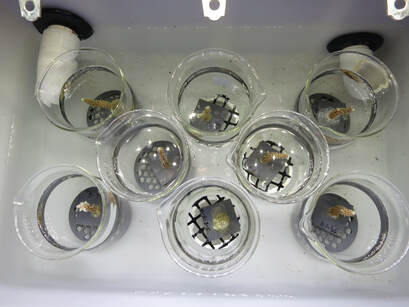Nutrient Cycling in Marine Invertebrates:Tight nutrient coupling between various trophic levels is thought to be critical for maintaining productive coral reef systems which are often found in highly oligotrophic waters with very low concentrations of nutrients. Symbioses with zooxanthellate algae in the host's gastrodermal cells provide the coral with photosynthetically derived carbon. Heterotrophic feeding and additional symbioses with nitrogen fixing bacteria also provide the coral with nutritional inputs. While coral symbioses are well studied, the pelagic microbial community as a source of nutrition for reef corals is less understood yet may play an important role in nutrient cycling within coral reef ecosystems. Using a combination of 16s sequencing and flow cytometry, we are characterizing the pelagic microbial community and wether or not corals are directly feeding upon it. This numerically abundant source of nutrition could be particularly important during thermal stress conditions when corals are even more reliant on heterotrophy as their main supply of energy.
|
Algal Ecophysiology:The environmental resilience of a coral can be derived from the unique host/algal combinations they form with the dinoflagellate alga, Symbiodiniaceae (also referred to as Zooxanthellae). Certain zooxanthellate species can form highly specialized symbioses with specific host corals, whereas others are more general and can be found within various coral species. These different host/algal combinations have significant impact on the coral colony’s health and resistance to environmental stress. Individual zooxanthellate species can be evolutionarily separated from one another by over 100 million years. However, we still have very little understanding of the physiological differences across this algal lineage and how various species cope with environmental stress. Using a combination of physiological and molecular techniques, our goal is to match phenotypic diversity with the known genetic variability in this group.
|
Model Systems and Photobioreactors:Model systems have always been a critical tool for research and the sea anemone (Aiptasia pallida) plays this role for coral biology. Using this system, we are able to modify the anemone-algal symbioses by directly controlling which zooxanthellae species the host is partnered with, allowing us to directly compare symbiotic parthernships. Currently, we are using this system to address how phosphate limitation impacts ROS production by zooxanthellae under varying temperature conditions.
Similar to the use of model species to control symbiotic partnerships, we are also using highly controlled culturing techniques (Photo-bioreactor systems) to further deconstruct the coral-algal symbioses in order to directly manipulate the alga itself. The control afforded through the use of photo-bioreactor systems is critical for understanding and comparing complex physiological responses across various algal species as they cope with environmental stress. |
Instrument DevelopmentAlgal ecophysiology and instrument development are well paired as new insights and research questions lead to novel measurement platforms with potentially broader applications. Here, we are using open source hardware and software platforms that will allow us to non-invasively interrogate live algae within the water column, or living within coral tissue. This is achieved by measuring various fluorescent properties of the algae which provide information on how they utilize light for photosynthesis.Light is both a source of energy and stress for photosynthetic organisms. By using multiple wavelength of light to excite fluorescence within the algae, we directly compare physiological differences across algal species and better understand how they respond to environmental stress.
|









